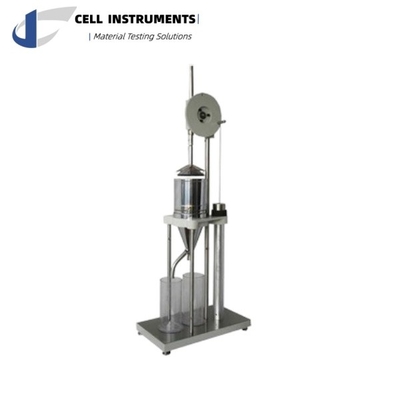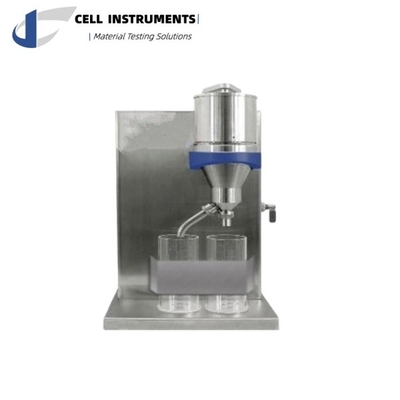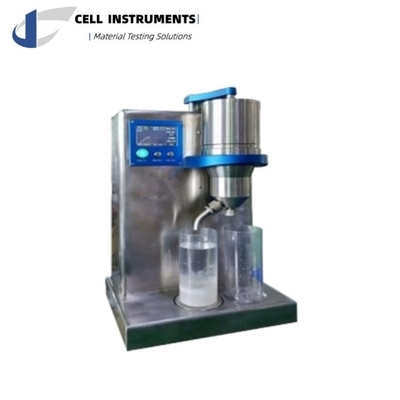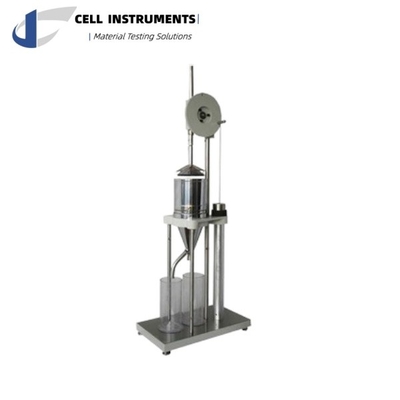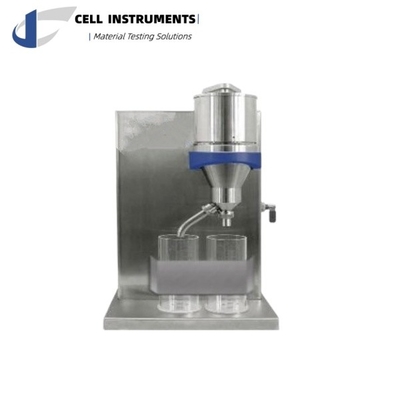Paper Beating Degree Detection Tester Pulp Drainage Speed Drainage Performance Testing for Pulp

Contact me for free samples and coupons.
WhatsApp:0086 18588475571
Wechat: 0086 18588475571
Skype: sales10@aixton.com
If you have any concern, we provide 24-hour online help.
x| Measuring Range | 1~100 SR | Division Value Of Measuring Cylinder | 1 SR |
|---|---|---|---|
| Orifice Draining Time | 149±1s | Residual Volume | (7.5~8.0)ml |
| Sealing Cone Raising Speed | 100±10mm/s | Dimension | 450*250*1200mm |
Paper Beating Degree Detection Tester Pulp Drainage Speed Drainage Performance Testing for Pulp
![]()
Paper Beating Degree Detection Tester plays a crucial role in determining the drainability of pulp suspensions, specifically measuring the Schopper-Riegler (SR) number. This highly specialized equipment is designed to measure the drainage speed and performance of pulp, ensuring consistency and accuracy in the papermaking process. Used in various industries including packaging, food, pharmaceuticals, and education, the Paper Beating Degree Detection Tester provides essential data for optimizing the quality of paper products. This product description will delve deeper into the instrument's function, benefits, working principle, and its application across multiple industries.
Overview of the Paper Beating Degree Detection Tester
| DJD-01 | |
| Measuring Range | 1~100 SR |
| Division Value of Measuring Cylinder | 1 SR |
| Orifice Draining Time | 149±1s |
| Residual Volume | (7.5~8.0)ml |
| Sealing Cone Raising Speed | 100±10mm/s |
| Dimension | 450*250*1200mm |
| DJD-02 | |
| Measuring Range | 1~100 SR |
| Operation | Auto Release |
| Sealing Adjustment | Auto Sealing |
| Side Orifice Adjustment | Adjustment button equipped, random setting of residual volume |
| Orifice Draining Time | 149±1s |
| Residual Volume | (7.5~8.0)ml |
| Sealing Cone Raising Speed | 100±10mm/s |
| Dimension | 410*360*760mm |
| DJD-03 | |
| Measuring Range | 1~100 SR |
| Display | Digital, drainage curve analysis |
| Resolution | 0.1 SR |
| Operation | Auto Release |
| Sealing Adjustment | Auto Sealing |
| Side Orifice Adjustment | Adjustment button equipped, random setting of residual volume |
| Orifice Draining Time | 149±1s |
| Residual Volume | (7.5~8.0)ml |
| Sealing Cone Raising Speed | 100±10mm/s |
| Dimension | 410*360*760mm |
The Paper Beating Degree Detection Tester is a precision instrument used to determine the drainage performance of pulp in water. This process, commonly known as "beating degree," helps assess the efficiency of the pulp’s fiber preparation. By accurately measuring the Schopper-Riegler (SR) number, this tester helps manufacturers ensure that their pulp products meet the required standards for drainability and fiber treatment.
The SR number reflects the rate at which a pulp suspension drains, which is indicative of the mechanical treatment the pulp fibers have undergone. This metric is essential for evaluating the quality of the paper pulp and ensuring that it meets specific requirements for various applications, particularly in industries such as packaging, pharmaceuticals, food, and paper production.
Key Features of the Paper Beating Degree Detection Tester
The Paper Beating Degree Detection Tester offers several advantages for laboratories and industries that depend on accurate pulp testing. These key features make the tester an indispensable tool for pulp manufacturers and quality control labs:
- Non-Corrosive Materials: Built with high-quality, non-corrosive stainless steel, the tester ensures longevity and resistance to harsh testing environments.
- Low Maintenance: The robust design minimizes the need for frequent maintenance, saving time and resources for laboratories.
- User-Friendly Operation: The tester is easy to operate and clean, making it an ideal choice for laboratories with high testing throughput.
- Precision Testing: Provides accurate results in compliance with international standards such as ISO 5627-1, GB/T 3332, and QB/T 1054.
Applications of the Paper Beating Degree Detection Tester
The Paper Beating Degree Detection Tester is widely used in several industries, including:
- Packaging Industry: Ensures that the paper pulp used in packaging materials has the appropriate drainage performance for strength and durability.
- Food Industry: Paper used for food packaging requires specific freeness levels to ensure it protects food products effectively.
- Pharmaceutical Industry: Accurate pulp testing ensures that medical packaging materials meet stringent regulatory requirements.
- Educational Institutions: Research and quality testing in academic settings benefit from the reliable results provided by the tester.
How the Paper Beating Degree Detection Tester Works
The Paper Beating Degree Detection Tester operates by measuring the drainage rate of a dilute suspension of pulp through a wire screen. The key steps in this process include:
- Pulp Suspension Preparation: A specific volume of pulp in an aqueous suspension is prepared and poured into the tester’s funnel.
- Draining Through Fiber Mat: The pulp forms a mat on the wire screen as the water drains through. This mat helps determine the drainability of the pulp.
- Measurement of Discharge: The tester measures the discharge from the side orifice into a calibrated cylinder, which is then converted into a Schopper-Riegler number.
- SR Number Calculation: The SR number corresponds to the amount of water retained in the pulp, with lower numbers indicating faster drainage and higher numbers showing slower drainage.
The process provides valuable insights into the paper pulp’s quality, helping manufacturers adjust their processes to achieve the desired paper properties.
Standards Compliance
The Paper Beating Degree Detection Tester adheres to several key industry standards that ensure accurate and reliable results. These include:
- ISO 5627-1: This international standard outlines the methods for determining pulp freeness using the Schopper-Riegler method.
- GB/T 3332: The Chinese standard for determining pulp drainability, which aligns with international testing protocols.
- QB/T 1054: A Chinese standard specifically focusing on the freeness of pulp and paper, ensuring the tester meets regional requirements.
Advantages of Using the Paper Beating Degree Detection Tester
- Consistent Results: The tester provides reliable data on the freeness of pulp, ensuring that manufacturers can maintain consistent product quality.
- Time-Efficient Testing: Quick and straightforward testing processes help manufacturers optimize their pulp production without sacrificing quality.
- Cost Savings: With low maintenance requirements and durable construction, the Paper Beating Degree Detection Tester offers long-term cost savings for laboratories and manufacturing plants.
- Compliance with Global Standards: By adhering to ISO and regional standards, this tester guarantees that your products will meet international quality requirements.
Frequently Asked Questions (FAQs)
1. What is the Schopper-Riegler number scale?
The Schopper-Riegler (SR) number measures the drainability of pulp. A discharge of 1,000 ml corresponds to an SR number of zero, while zero discharge corresponds to an SR number of 100. This scale helps manufacturers determine the degree of mechanical treatment the pulp has undergone.
2. What is 'stock' in the pulp beating freeness test?
'Stock' refers to the aqueous suspension of disintegrated pulp used in the freeness test. The consistency of this suspension is critical to ensuring accurate measurements.
3. Why is measuring the Schopper-Riegler number important?
Measuring the SR number is vital for assessing the pulp's drainage performance, which directly impacts the quality of the final paper product. Ensuring optimal freeness allows manufacturers to create stronger, more durable paper.
4. Can this tester be used for all types of pulp?
While the Paper Beating Degree Detection Tester is suitable for most types of pulp, extremely short-fibered pulps, such as well-beaten hardwoods, may produce less reliable results due to fiber loss through the wire screen.
5. How does this tester benefit the packaging industry?
In the packaging industry, maintaining the proper drainage performance of pulp ensures that the paper used for packaging materials is strong, durable, and meets the necessary specifications for protecting products during transportation and storage.
![]()
![]()



